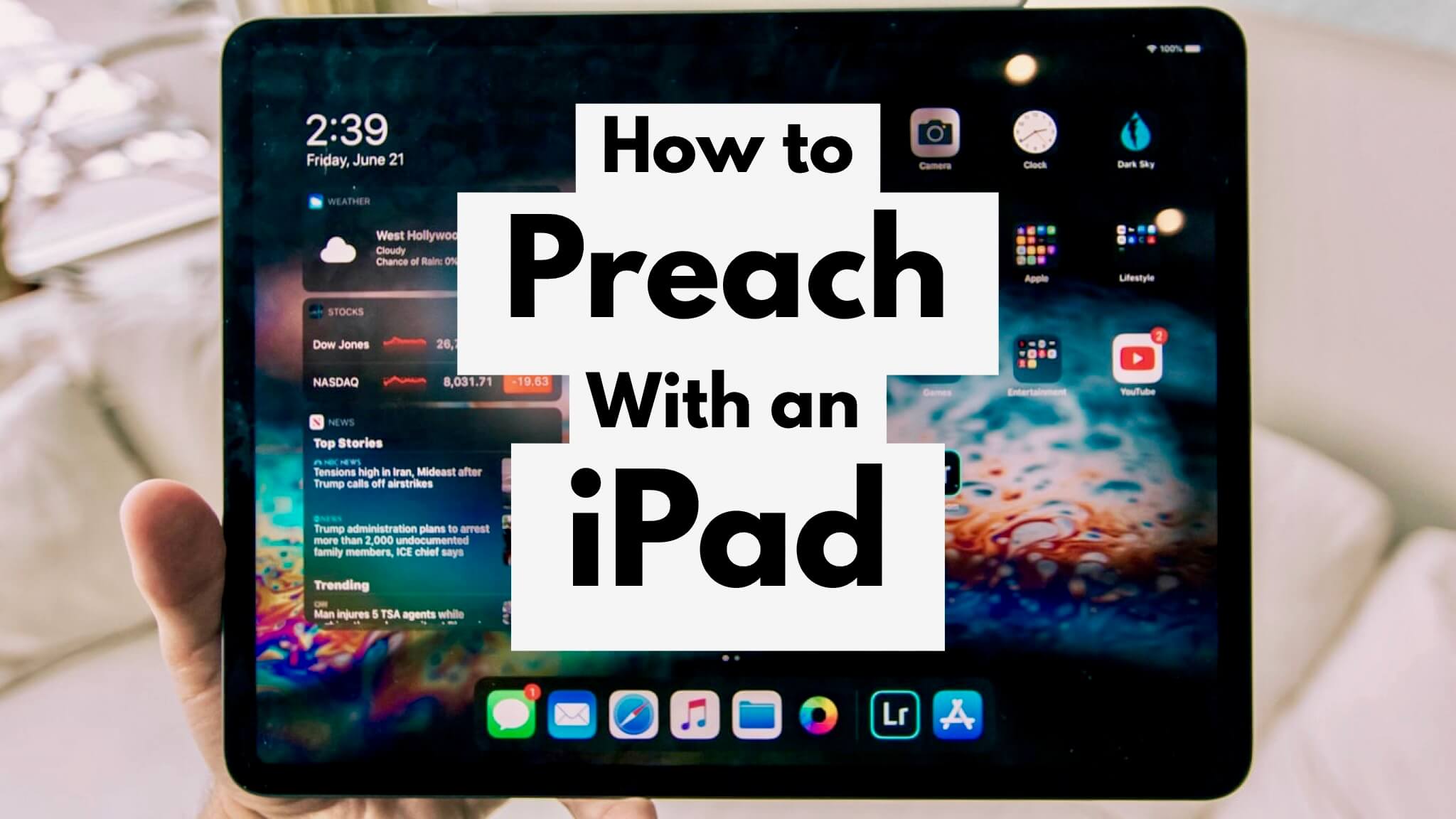What Infomercials Can Teach Us About Preaching
 Believe it or not, preachers can learn a ton from infomercials.
Believe it or not, preachers can learn a ton from infomercials.
Why? Because as cheesy as some of these infomercials can be, they are highly effective at what they are created to do – sell.
Marketing experts are paid millions of dollars a year to research and test marketing strategies that improve product sales.
The next time you see an infomercial for a Snuggie or P90X, take notes. They all follow the same 5-step process:
Problem > Solution > Testimony > Action > Urgency
So what does this have to do with preaching you ask? Everything!
Every public speaker is trying to sell something – either a product, service, or idea. Every speaker is trying to get the audience to buy what they are saying.
Preachers are the same. We sell Biblical ideas. We are trying to persuade people to buy into the truth that Jesus Christ is the only way to salvation.
Allow me to break the 5-step process down and show you how it applies to preaching.
The 5-Step Infomercial Preaching Strategy
#1 Problem
“Are you tired of…? Don’t you hate it when…? Are you embarrassed because…? Do you struggle with…?”
Infomercials always start with the problem.
This is also the best way to begin a sermon. Identify a problem that your audience is dealing with.
The easiest problems are the ones they already know they have: an addiction, a failing marriage, or no direction or purpose in life.
However, many times you may need identify a problem that they didn’t even know about. You have to educate them about why it is a big problem. These are things like sin, idolatry, a life without Christ, etc.
Start your message by identifying the problem. Add drama. Tell a story that illustrates the problem. Build the tension.
Make the audience beg for a solution and you have captured their attention.
#2 Solution
“Here is a revolutionary new product that will make this problem disappear!”
After the problem is identified, infomercials immediately introduce you to their product that will solve this problem forever.
Now that the audience is begging for a solution, the second step in your sermon is to give it to them. Propose a way to eradicate the problem and forever change their lives.
This is where you point to the Bible. “Here is a story about the same problem.” “Here is what Jesus said.” “Here is how Jesus solves this problem.”
Ultimately, the solution for a preacher should always be the Gospel. The answer to all of life’s problems is Jesus. We will never be good enough. Jesus is the only righteous person to ever walk the earth. Jesus alone is the ultimate solution.
Show your audience how you want to help them. Show them how Jesus can improve their lives.
#3 Testimony
“Listen to what John, Kim, Greg, and Jill have to say! This product changed their lives!”
To give credibility to their product, all infomercials include testimonies from average people about how great the product is, or what awesome results they achieved.
After you have proposed the solution, the third step is to erase doubts. The first question people in the audience will think is, “Does this really work?”
Rather than telling them, “This really works!” Show them that it works.
In the marketing world this is called social proof. People are more likely to buy something if people write good reviews about it. People are more likely to try something new if someone else recommends it.
Tell stories of people who have overcome the problem by giving their life to Christ. Tell stories of people’s lives that have changed forever because of Jesus.
Research, scientific data, and quotes from dead guys are all good, but none of it compares to a real person telling how Jesus changed their life.
Stories are powerful.
#4 Action
“Buy it now for only $19.95! Just call 1-800-555-5555.”
Every infomercial ends with a clear call to action. There is no doubt on what they want you to do. Call this number and buy it today!
The fourth step is the most critical part of your sermon. What do you want people to do with what you have just told them?
Be careful here. This is where most preachers mess up. They end with 7 different things a person can do. They overload the audience with too many actions to take, so the audience does none of them.
What one thing do you want them to do? Pick the single most important action they need to take and communicate it clearly and simply as you possibly can.
A great sermon with a lame call to action is pointless. You must have a single, specific action that you want the people in your audience to take immediately.
#5 Urgency
“But wait, there’s more! Order in the next hour and you get this other cool thing for absolutely free! Hurry while supplies lasts!”
The final hook infomercials use is a sense of urgency. They present you with a limited time offer or a great deal that you don’t want to miss out on. They make people act fast, because they know that the longer it takes a person to act, the less likely they will do anything at all.
Finish your sermon with why it is absolutely crucial that they act immediately.
What is at stake if they don’t act now? What could happen to their life? If they continue with life as usual, what incredible things will they miss?
This is where you cast a compelling vision. Urge them to not waste another second of their lives living in sin. Call them to repentance in Jesus.
Conclusion
Are you tired of the same boring sermons? Do you want to instantly improve your preaching?
The 5 Step Strategy is exactly what you need! It has the power to super-charge your preaching.
But don’t just take my word for it. Look at every great preacher out there. They are all doing a variation of this exact same thing, whether they know it or not, because it works!
So what are you waiting for? Act now.
(See what I just did there?)




Thanks alot for this write up.
.
imagine you wanted to make a prayerless church to become more prayerful and your only chance was to preach a one time sermon- they have heard alot about this and are still carefree.
.
The only option is to make the see how it is destroying their lives then you provide prayer as a solution and make them start NOW!
.
Thats informercial.
THIS IS EXCELLENT!!!
Are we really just trying to “sell” Jesus to people when we preach? Are we really asking people to give us their Sunday morning in order to sit through an info-mercial about Christianity? Was Jesus just another salesman pitching “miracle knives” and food processors? I don’t think so. Informercials are designed to get people’s money quick in a completely impersonal, non-relational context – Somehow that doesn’t sound like the gospel of Jesus Christ.
I see how you can feel that way, but I think you misunderstood the intent of the post. Yes, it’s not about selling Jesus. It’s not about trying to be a salesman or make money. It is about persuasive preaching.
It’s similar to how Paul used the philosophy of the culture in Athens on Mars Hill (Acts 17). He used what worked in their culture to try to persuade them to believe in Jesus.
It’s not about dumbing down the Gospel. It’s about presenting the greatest news of all time in a way that is effective in our culture today.
Setting up the problem of sin. Showing the only solution in Christ. Sharing our testimony and the testimonies of others. And urgently calling them to repentence.
That is how great Gospel preachers have been doing it for centuries.
Thanks for the clarification. My point is that we have to be very thoughtful about what cultural forms we use in our conveyance of the gospel. What were those forms designed to do in our culture? Are we actually trying to DO the same thing that they are? My suggestion is that infomercials have been carefully designed to get people to BUY things. They are about an impersonal exchange of money and goods that will likely not have a lasting impact on the life of either the seller or the purchaser. The gospel is about long-term transformation that happens in the context of real relationships (the church). If we want to be true to that message we need to be careful not to package it in a form that was meant to do something else.